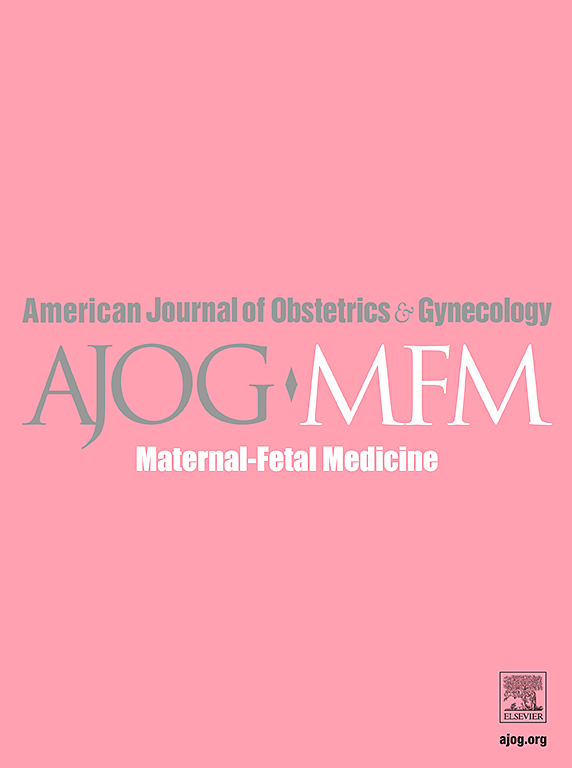因宫颈过短(≤10.0 毫米)而接受宫颈环扎术的无症状患者的早产率和潜伏期。
IF 3.8
2区 医学
Q1 OBSTETRICS & GYNECOLOGY
American Journal of Obstetrics & Gynecology Mfm
Pub Date : 2024-10-05
DOI:10.1016/j.ajogmf.2024.101496
引用次数: 0
摘要
目的:估算无症状、无早产史、宫颈长度(CL)≤10.0 mm、接受或未接受宫颈环扎术、未使用阴道黄体酮治疗的妇女的早产率(PTD)和平均分娩潜伏期:对无症状单胎妊娠且无早产史的患者进行回顾性分析,这些患者在中期妊娠扫描时偶然发现经阴道超声测量的宫颈长度(CL)≤10.0 mm,其中56人(63.6%)接受了宫颈环扎术,32人(36.4%)未接受宫颈环扎术,他们均未使用阴道黄体酮。有证据显示胎盘晚期扩张、胎膜脱垂、胎膜破裂或感染阳性体征的孕妇不适合进行宫颈环扎术,这些孕妇被排除在分析之外。计算了两组间早产发生率、平均分娩胎龄和极短宫颈鉴定至分娩的平均潜伏期的差异。在对产妇特征和胎儿体重进行调整后,估计了宫颈环扎与早产之间的关系:结果:在测量CL时,宫颈环扎组的中位胎龄(范围)为(周/天)20w6d(17w5d-23w3d),而未进行宫颈环扎组的中位胎龄为21w5d(17w6d-23w6d)(P=0.02)。进行了宫颈环扎的产妇(5.9 mm (SD 3.1 mm))与未进行宫颈环扎的产妇(6.5 mm (SD 3.2 mm);P=0.4)的CL没有差异。使用宫颈环扎术的产妇与未使用宫颈环扎术的产妇的早产(PTD)发生率分别为PTD 结论:在中期妊娠扫描中宫颈很短(≤10.0 mm)的低风险无症状妇女中,与期待疗法相比,采用宫颈环扎术的妇女分娩潜伏期更长,早产发生率更低。本文章由计算机程序翻译,如有差异,请以英文原文为准。
Rate of preterm delivery and latency period in asymptomatic patients undergoing cerclage for very short cervix ≤10.0 mm
BACKGROUND
In asymptomatic women with cervical length ≤10 mm, vaginal progesterone has a limited effect in reducing the rate of preterm delivery.
OBJECTIVE
This study aimed to estimate the rate of preterm delivery and mean latency period to delivery in asymptomatic women with no history of preterm delivery and a cervical length of ≤10.0 mm undergoing or not undergoing cerclage and who were not treated with vaginal progesterone.
STUDY DESIGN
This was a retrospective analysis of asymptomatic patients with singleton pregnancies and no history of preterm delivery with an incidental finding of a cervical length of ≤10.0 mm measured by transvaginal ultrasound during midtrimester scan. Of note, 56 patients (63.6%) underwent cerclage placement and 32 patients (36.4%) did not, none of them received vaginal progesterone. Patients with evidence of advanced dilation, prolapsing membranes, ruptured membranes, or positive signs of infection were not candidates for cerclage placement and were excluded from the analysis. Differences in the prevalence of preterm delivery, mean gestational age at delivery, and mean latency from very short cervix identification to delivery between the 2 groups were calculated. Associations between cerclage and preterm delivery adjusted for maternal characteristics and fetal weight were estimated.
RESULTS
The median gestational ages at the time of cervical length measurement were 20 6/7 weeks (interquartile range, 17 5/7 to 23 3/7) in the cerclage group and 21 5/7 weeks (interquartile range, 17 6/7 to 23 6/7) in the no-cerclage group (P=.02). No difference in cervical length was observed between patients who had a cerclage (5.9±3.1 mm) and those who did not have a cerclage (6.5±3.2 mm) (P=.4). The prevalence of preterm delivery in women with cerclage vs women without cerclage was as follows: PTD at <37 weeks of gestation (31/56 [55.3%] in the cerclage group vs 28/32 [87.5%] in the no-cerclage group; adjusted odds ratio, 0.17; 95% confidence interval, 0.05–0.62; P=.008), PTD at ≤34 weeks of gestation (27/56 [48.2%] in the cerclage group vs 24/32 [75.0%] in the no-cerclage group; adjusted odds ratio, 0.16; 95% confidence interval, 0.05–0.55; P=.02), and PTD at ≤28 weeks of gestation (19/56 [33.9%] in the cerclage group vs 22/32 [68.7%] in the no-cerclage group; adjusted odds ratio, 0.15; 95% confidence interval, 0.05–0.51; P=.002). The median gestational ages at delivery were 32 6/7 weeks (interquartile range, 19 1/7 to 40 1/7) in the cerclage group and 28 1/7 weeks (interquartile range, 20 1/7 to 40 2/7) in the no-cerclage group (P=.001). The median latencies from the time of cervical length measurement to delivery were 84 days (interquartile range, 8–144) in the cerclage group and 43 days (interquartile range, 1–146) in the no-cerclage group (P=.003).
CONCLUSION
Among low-risk asymptomatic women with a very short cervix (≤10.0 mm) in the midtrimester of pregnancy, women treated with cerclage have an increased latency to delivery and a lower prevalence of preterm delivery than those treated with expectant management.
求助全文
通过发布文献求助,成功后即可免费获取论文全文。
去求助
来源期刊

American Journal of Obstetrics & Gynecology Mfm
Medicine-Medicine (all)
CiteScore
7.40
自引率
3.20%
发文量
254
审稿时长
40 days
期刊介绍:
The American Journal of Obstetrics and Gynecology (AJOG) is a highly esteemed publication with two companion titles. One of these is the American Journal of Obstetrics and Gynecology Maternal-Fetal Medicine (AJOG MFM), which is dedicated to the latest research in the field of maternal-fetal medicine, specifically concerning high-risk pregnancies. The journal encompasses a wide range of topics, including:
Maternal Complications: It addresses significant studies that have the potential to change clinical practice regarding complications faced by pregnant women.
Fetal Complications: The journal covers prenatal diagnosis, ultrasound, and genetic issues related to the fetus, providing insights into the management and care of fetal health.
Prenatal Care: It discusses the best practices in prenatal care to ensure the health and well-being of both the mother and the unborn child.
Intrapartum Care: It provides guidance on the care provided during the childbirth process, which is critical for the safety of both mother and baby.
Postpartum Issues: The journal also tackles issues that arise after childbirth, focusing on the postpartum period and its implications for maternal health. AJOG MFM serves as a reliable forum for peer-reviewed research, with a preference for randomized trials and meta-analyses. The goal is to equip researchers and clinicians with the most current information and evidence-based strategies to effectively manage high-risk pregnancies and to provide the best possible care for mothers and their unborn children.
 求助内容:
求助内容: 应助结果提醒方式:
应助结果提醒方式:


